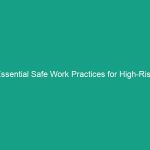Good Morning Team!
Today, we’re diving into an essential aspect of Workplace Safety: Bystander Intervention. This Toolbox Talk will explore how we can effectively encourage each other to speak up in order to create a safer Environment for everyone. It’s crucial because, when we look out for one another, we not only protect ourselves but also foster a culture of Safety and accountability.
Understanding Bystander Intervention
Bystander Intervention refers to the actions taken by individuals who witness unacceptable behavior or situations that could lead to harm, thereby stepping in to prevent potential incidents. In the context of Workplace Safety, this means recognizing hazardous situations and having the courage to speak up, whether it’s about unsafe practices, equipment issues, or even behavioral concerns.
The importance of bystander intervention cannot be overstated. When we actively engage in this practice, we contribute to a proactive Safety culture, reducing the risk of accidents and injuries. Many employees, however, may think that if they are not directly involved in a situation, it’s not their responsibility to intervene. This misconception can be dangerous and must be addressed.
Key Hazards, Risks, and Safety Considerations
There are several Hazards and risks associated with ignoring the principles of bystander intervention:
- Accidents: Failing to address unsafe behaviors can lead to workplace accidents, resulting in injury or even fatalities.
- Workplace Culture: A culture that discourages speaking up can lead to a negative work environment, impacting morale and productivity.
- Legal Consequences: Companies may face legal ramifications if they do not take appropriate action in response to unsafe practices.
Real-world consequences can include severe injuries, financial losses, and even loss of life. It’s critical to create an atmosphere where everyone feels empowered to act when they see something concerning.
Best Practices, Procedures, & Actionable Advice
What can we do to ensure that we are all actively participating in bystander intervention? Here are some Best Practices:
1. Recognize the Signs
Understanding when intervention is necessary is the first step. Look for signs such as:
- Unsafe equipment usage
- Ignoring safety protocols
- Unaddressed behavioral issues (e.g., harassment, bullying)
2. Assess the Situation
Before intervening, quickly assess the situation. Ask yourself:
- Is someone in immediate danger?
- Can I intervene safely without escalating the situation?
- What’s the best way to address this concern?
3. Choose Your Intervention Method
There are several ways to intervene:
- Direct Intervention: If it’s safe to do so, directly address the behavior. For example, if you see someone not wearing a hard hat in a construction zone, kindly remind them of the safety requirement.
- Indirect Intervention: If direct intervention may escalate the situation, report your concerns to a supervisor or safety officer.
- Supportive Intervention: Encourage colleagues to speak up. Sometimes, all it takes is a little encouragement from a peer to foster a culture of safety.
4. Report Concerns
If you feel uncomfortable intervening directly, it’s essential to report the concern to a supervisor or safety officer. Documenting incidents can help the company address systemic issues and improve safety protocols.
5. Follow Up
After intervening or reporting, follow up to ensure that appropriate actions were taken. This demonstrates that you care about the safety of your colleagues and reinforces the importance of bystander intervention within your team.
Regulations, Standards, and Compliance
Understanding the regulatory framework surrounding Workplace Safety is essential. Relevant organizations such as OSHA (Occupational Safety and Health Administration) emphasize the importance of a safe working environment and encourage employees to report unsafe conditions.
Compliance with safety Standards not only protects employees but also minimizes liability for the company. Engaging in bystander intervention aligns with these Regulations and fosters a culture of safety.
Employee Engagement & Discussion
Now, let’s open the floor for discussion. Here are a few questions to consider:
- What safety challenges have you encountered related to bystander intervention?
- Have you ever witnessed a situation where you felt you should intervene? What happened?
- What ideas do you have for encouraging more open communication about safety concerns?
Take a moment to think about these questions and share your thoughts with the group. It’s important that we learn from each other’s experiences.
Conclusion & Key Takeaways
To wrap up, bystander intervention is a vital component of Workplace Safety. By recognizing unsafe behaviors and taking action, we can protect ourselves and our colleagues. Remember:
- Recognize the signs of Unsafe Behavior.
- Assess the situation before intervening.
- Choose the most appropriate intervention method.
- Report concerns if necessary.
- Follow up to ensure action is taken.
Thank you all for your attention today and your commitment to maintaining a safe workplace. Remember, safety is everyone’s responsibility, and together, we can create a culture where everyone feels empowered to speak up for safety.


